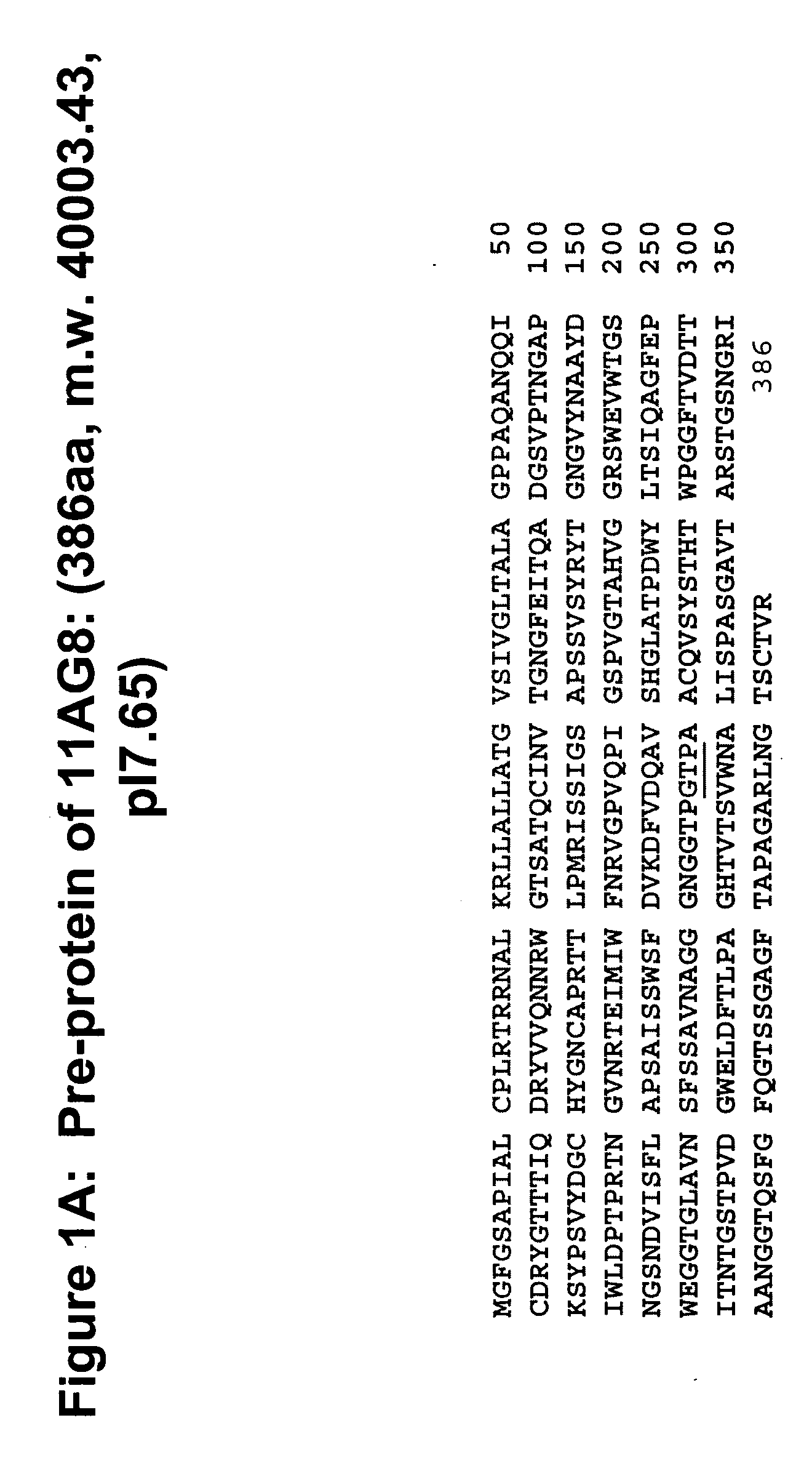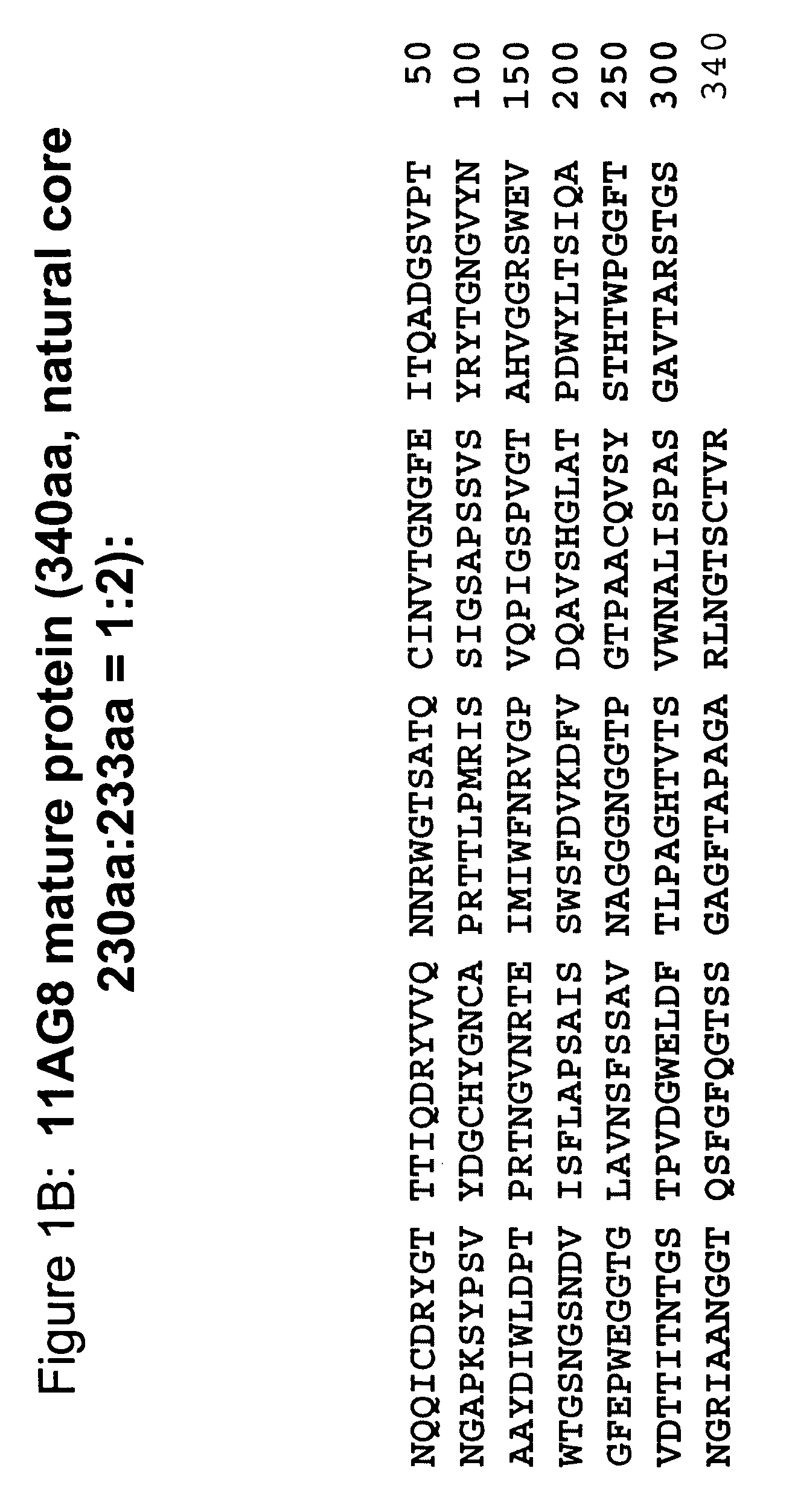Neutral cellulase catalytic core and method of producing same
a technology of neutral cellulase and catalytic core, which is applied in the direction of non-surface active detergent compositions, enzymology, textiles and paper, etc., can solve the problems of only a small attention of the third group of cellulases, grey cast on the fabric, and a small number of dyes, so as to reduce redeposition of dyes, improve fabric hand, and increase abrasion
- Summary
- Abstract
- Description
- Claims
- Application Information
AI Technical Summary
Benefits of technology
Problems solved by technology
Method used
Image
Examples
example 1
Construction of Vectors
[0121] This example illustrates the construction of plasmids comprising the novel cellulase catalytic core.
[0122] A pSEGCT11AG8 vector containing a GI promoter as shown herein as FIG. 3 and described in example 6 of U.S. Pat. No. 6,562,612 was used as the basis for the production of the vectors used in the present invention. The pSEA4CT-11AG8 vector construction is described in Example 2 of U.S. patent application Ser. No. 10 / 992,149 (filed Nov. 18, 2004) and reference is made to FIG. 4 of the present application (map of pSEA4CT-11AG8).
[0123] Plasmid pKB105 was constructed from plasmid pSEA4CT-11AG8 by replacing the segment encoding the full-length 11AG8 cellulase with a sequence encoding the novel cellulase catalytic core. See FIG. 5 (wherein the sequence encoding the novel cellulase catalytic core is designated as “11AG8 Core I”. FIG. 6 shows the pKB105 vector.
[0124] The novel cellulase catalytic core expression vector, pKB107, was derived from pKB105. R...
example 2
Expression and Activity
[0125] The following example describes the expression and activity of the novel cellulase.
2A. Transformation and Expression
[0126] The expression vectors, pSEA4CT-11AG8 and pKB107, constructed in Example 1 were used in this example.
[0127] In these experiments, the host Streptomyces lividans cells were transformed with the vectors described above. The transformation techniques were the protoplast method described in Hopwood, et al., GENETIC MANIPULATION OF STREPTOMYCES, A LABORATORY MANUAL. The John Innes Foundation, Norwich, United Kingdom (1985).
[0128]Streptomyces lividans cells were transformed with one of the expression vectors as described above. Transformed cells were plated on azo-CMC plates and colonies expressing a cellulase were identified by production of a “halo”. Colonies producing a halo were grown in TS in shake flasks for 3 days in the presence of 50 ug / ml thiostrepton at 30° C. Cells were then transferred to a production medium free of anti...
example 3
Wash Performance
[0139] The following example compares the wash performance of a granulated experimental novel catalytic core sample KB107C blend (95% KB107C+5% IndiAge® Neutra L) against a commercial 11AG8 product, IndiAge® Neutra G (Genencor Intl.). The enzymes were dosed using same total ONPC activity per run.
[0140] The experimental procedure for the 35 kg denim substrate can be summarized as follows:
[0141] Step 1: Desizing (55° C. / 20 min)
[0142] Step 2: Drop & Rinse
[0143] Step 3: Cellulase Treatment (55° C. / pH 6.5 / 60 min)
[0144] Step 4: Cold Rinse (1-2 min)
[0145] Step 5: Hot Rinse (70° C. / 5 min)
[0146] Step 6: Cold Rinse (1-2 min)
[0147] Step 7: Extract at Extractor
[0148] Step 8: Drying at tumbling dryer
[0149] Step 9: Evaluation
Trials
[0150] Desizing was done with 0.57 g / L formulated Optisize and 0.25 g / L Triton X-100 at 55° C. for 20 minutes.
[0151] Desized denim substrates were treated with new granule (95% KB107C+5% IndiAge® Neutra L) and IndiAge® Neutra G in a produc...
PUM
| Property | Measurement | Unit |
|---|---|---|
| Fraction | aaaaa | aaaaa |
| Fraction | aaaaa | aaaaa |
| Fraction | aaaaa | aaaaa |
Abstract
Description
Claims
Application Information
 Login to View More
Login to View More - R&D
- Intellectual Property
- Life Sciences
- Materials
- Tech Scout
- Unparalleled Data Quality
- Higher Quality Content
- 60% Fewer Hallucinations
Browse by: Latest US Patents, China's latest patents, Technical Efficacy Thesaurus, Application Domain, Technology Topic, Popular Technical Reports.
© 2025 PatSnap. All rights reserved.Legal|Privacy policy|Modern Slavery Act Transparency Statement|Sitemap|About US| Contact US: help@patsnap.com



